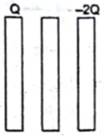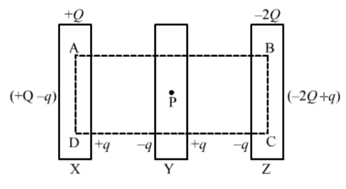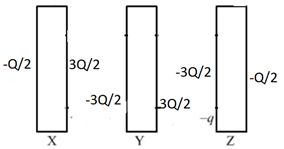Three identical metal plates with large surface areas are kept parallel to each other as shown in figure. The leftmost plate is given a charge Q, the rightmost a charge –2Q and the middle one remains neutral. Find the charge appearing on the outer surface of the rightmost plate.

Given:
Charge on the left plate =Q
Charge on the rightmost plate =-2Q
Consider the gaussian surface as shown in fig.
Two faces of this closed surface lie completely inside the conductor where the electric field is zero. The other parts of closed surface which are outside are parallel to electric field and hence flux on these parts is zero. The total flux of electric field through this closed surface is zero. So, from gauss’s law total charge inside the closed surface be zero

To find the value of q consider electric field at point P
We know that electric field due to a thin plate of charge Q is given by
![]()
Where A=area of plate
Now electric field at point P due to,
Outer surface of plate X=![]() (towards right)
(towards right)
Inner surface of plate X=![]() (towards right)
(towards right)
(towards left)
Right surface of plate Y=![]()
(towards left)
Inner surface of plate Z=![]() (towards right)
(towards right)
Outer surface of plate Z=![]() (towards right)
(towards right)
Consider field towards right as positive and towards left as negative
Net field at point P is given by
![]() +
+![]() =
=![]()
We know that field inside a point inside conductor should be zero
∴ net field at p=0
![]()
![]()
The final charge distribution is shown in fig.

Charge on the outer surface of rightmost plate is given by![]()
Therefore, the charge on the outer surface of the rightmost plate is given by -Q/2